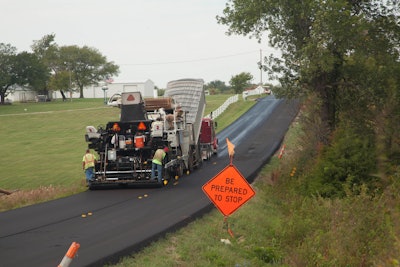
One would expect that an incredibly long highway that connects Mexico and Canada would have tons of songs, myths, and stories written about it. But not so. The lore of U.S. Route 62 or U.S. Highway 62 (US 62) probably does exist in family stories and communities along the way, but has not yet migrated its way out into popular culture. Surprisingly, there are no "Get Your Kicks on Route 62" song or a Route 62 television show.
But US 62 is a big deal. It runs 2,248 miles from the Mexico-US border at El Paso, TX, to Niagara Falls, NY, at the Canada–US border. It is the only east-west United States numbered highway that connects the two countries.
A 7.5-mile section of US 62 in Oklahoma recently received a rehab. The Oklahoma Department of Transportation (ODOT) project started in Blanchard, OK, and headed west. Blanchard is part of a rapidly growing area of northern McClain and Grady Counties known as the "Tri-City Area" with Newcastle and Tuttle.
The project section of US 62 is special because the road was built in 2000 when ODOT was switching from conventional HMA to Superpave. The contractor back then was getting used to Superpave and the mix used was too low on oil. Superpave was originated from a Strategic Highway Research Program (SHRP), an initiative whose mandate was to improve materials, selection and mixture design by developing what became known as the Superior Performing Asphalt Pavement System or Superpave.
Unfortunately, the road did not last as well as anticipated – it showed premature wear and deterioration, which necessitated its replacement. In addition, the area where this section of US 62 is located has experienced population growth so the road is receiving a greater traffic load.
Establishing ride quality
Markwell Paving Co., Oklahoma City, OK, was selected as the contractor for the U.S. Highway 62 rehab project. Established in 1962, Markwell is a medium-size, third generation family-owned paving company serving the central Oklahoma market with 80 employees. The company offers excavation, soil stabilization, milling, asphalt and concrete paving, sealcoating and striping.
“A good 97% of our work is roadwork,” says Mike Boatman, general superintendent with Markwell Paving. “The US 62 project is exactly the kind of work we do best.”
Markwell used its Roadtec RX-700e heavy-duty milling machine, equipped with a 10’6” width cutter drum. The half-lane cold planer features a four-track suspension, dual water spray bars, and 120-degree conveyor swing, which allows feeding a truck in an adjacent lane or around a tight bend.
“The ride quality road of the road had deteriorated and required a two-inch milling depth to establish a base,” Boatman says. “We used a five-worker milling crew to complete the road milling portion of the project. The milling was a bit of a challenge, but we were running a good cold planer.”
On its paving team, Markwell Paving had a crew of eight. They placed a two-inch lift of a locally-sourced RIL (Ridge Intermediate Layer) course directly on top of the uniformly level milled surface. This 14,000 tons of base course contains more oils and additives to bind the milled surface with the top two layers of HMA.
“The RIL mix is very finicky to work with as far as ambient temperature,” says Boatman. “Weather delays we experienced on this project were pretty much during the RIL paving due to temperatures falling outside the material’s application comfort zone.”
The company used its gravity-fed Roadtec SP-100e Stealth paver on the US 62 highway rehab project. The Stealth paver machine gravity feeds material directly to the auger from the mass flow hopper, replacing the need for slat conveyors, hopper wings, push rollers and tandem front boggies, thereby significantly reducing maintenance costs over a conventional 10-foot paver.
The paver works in tandem with a Roadtec SB-2500e Shuttle Buggy material transfer vehicle (MTV), which provides a steady flow of HMA to the paver. The Shuttle Buggy’s remixing action is designed to reduce thermal and/or material segregation problems.
Markwell placed a two-inch lift of Oklahoma S4 Superpave mix surface course on top of the base course. A quantity of 14,000 tons of Oklahoma S4 Superpave HMA was used.
The SP-100e Stealth paver then placed 8,000 tons of Oklahoma S5 Superpave HMA as a mainline finish course on the stretch of U.S. Highway 62.
ODOT has studied and tested the thermal cracking resistance of the Oklahoma S4 and Oklahoma S5 HMA mixes and found them to be stiffer, as indicated by higher creep compliance and indirect tensile strength values. Markwell Paving used the HMA mixes specified by ODOT to meet their requirements.
Maximizing smoothness
ODOT smoothness requirements are stringent. With a straight-edge test, there can’t be more than a 1/8th-inch variance in a 10-foot section.
“We beat the ODOT smoothness test and have paved what I’d argue is likely the smoothest section of US 62 in its entirety,” Boatman stated. “We understand that 40% of our ability to do so well on a paving job is the equipment and the Stealth is clearly the significant contributor. And the other 60% is the crew – we have exceptional, experienced people.
“The Stealth paver has been tremendously productive for us. We have four different guys that can run the Stealth – they all love it. Every project we’ve used this paver on, we’ve achieved the bonus. Our Stealth is the first Tier 4 e-series model Roadtec sold – serial number 3001. We literally bought it off the display floor at ConExpo 2014. The only modification we made was to change the screed to a Roadtec Eagle Screed.”
With Markwell Paving being the first to buy the gravity-fed Roadtec SP-100e Stealth paver, it begs the question why? What sold them on the Stealth?
“There are three reasons why buying this paver was for us a no-brainer," says Boatman. "First, savings. The initial purchase price is substantially lower than a conventional paver. The ownership costs are lower — fewer moving parts means less maintenance. Plus, there are lower fuel costs.
“Second, the machine is easy to operate," he continues. "It can be operated from either side of the paver, which makes it visually easy to remain on top of the job.
“And last, we get higher production because of the machine’s large 20-ton capacity hopper holds a full load from a 10 wheeler and we have faster production. The typical daily production with conventional paver is 1,500 to 1,800 tons per day – with the Stealth we’ve laid down as much as 3,000 tons in a day.”
As the U.S. Route 62 highway rehab project comes to its end, Boatman gets to reflect on what will be his biggest takeaway from the project … the smoothness of the finished mat.
“Driving the 7.5-mile stretch of Route 62 that we worked on should make any of us with the company feel proud of the work we’ve done. It is definitely the smoothest road in this part of the country.”
For more information on the Roadtec SP-100e Stealth paver, visit ForConstructionPros.com/asphalt and Search 12220784 for "Gravity-Fed Asphalt Paver is Effective on Highway Jobs."















